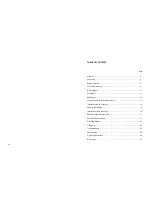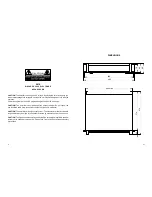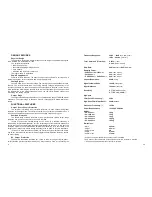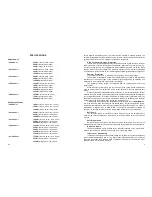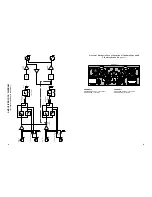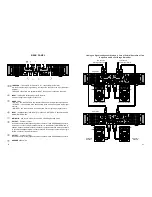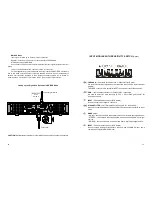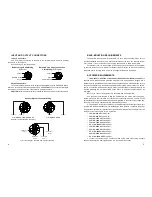
28
5
output signal to a speaker system. To prevent any DC damage to speaker systems, the
amplifier incorporates the triak protection system for each channel, which short-circuits the
amplifier output in case of DC voltage or powerful LF fluctuations.
High Frequency Energy Protection
In case of any powerful high frequency fluctuations caused by bad contact in the input
cable connectors or those transmitted to the amplifier input from any other device (e.g.
crossover, mixing console, etc.), the protection system enables the built-in clip-limiter, which
reduces the level of the input signal. This protection system serves to prevent any damage
to tweeters as might be caused by non-musical signals of powerful high frequency spectrum.
Thermal Protection
The thermal protection is to preclude any overheating of the output stage.
The amplifier incorporates a double-step thermal protection system which precludes
overheating of the output stage of the amplifier without suspending its operation and
disabling the input signal (and output signal, accordingly).
The thermal protection system is coordinated with the cooling system and in the
following way.
When the output power is fairly low, the fan runs at a low speed. As the output power
goes up and so rises the temperature of the output transistors, the fans gradually gain
speed.
Whenever the output stage temperature reaches 85
°
Ñ
, the thermal protection system
disables the upper voltage of the output stage, thus significantly reducing the output power
of the respective channel. This status is indicated by a slightly (half-) lit ALARM LED. The
adequate sound quality in this case is provided by the built-in optoelectronic Clip-limiter
which reduces the input signal level, should any distortion occur.
If overheating of the output stage persists and its temperature rises to 95
°
Ñ
(as a rule,
this is the case only when the cooling fan has broken down), the thermal protection system
inhibits the input signal as well as the output stage of the respective channel. This status is
indicated by a brightly (full-) lit ALARM LED. The amplifier automatically resumes its
operation, in the reverse order, after the output stage transistors have cooled down.
Soft Start
The soft start system is provided to reduce inrush current to the amplifier and to
minimize the noise contributed by the amplifier to the power mains during the power-on
process.
Soft Signal Start
During the power-on process, this feature ensures smooth gain from zero to the
maximum level to provide for a smooth rise of the sound level emitted from the loudspeakers.
Balanced Inputs
The use of balanced inputs provides for an essential reduction of the environment-
induced hum and noise interference with long input connecting cables.
Input Level Attenuators
Located on the front panel, these allow setting the amplifier to the required sensitivity
(each channel individually) which is very helpful when several amplifiers run in parallel,
especially when they drive different types of speaker systems or are used within multi-
speaker sound reinforcement systems.
Output Power:
–
V4-900
MkIII
450W
(channel, 4Ohm, 230V)
280W
(channel, 8Ohm, 230V)
900W
(bridge, 8Ohm, 230V)
–
V4-1200
MkIII
600W
(channel, 4Ohm, 230V)
330W
(channel, 8Ohm, 230 V)
1200W
(bridge, 8Ohm, 230V)
–
V4-1800
MkIII
900W
(channel, 4Ohm, 230V)
500W
(channel, 8Ohm, 230V)
1450W
(bridge, 8Ohm, 230V)
–
V2-2400
MkIII
1200W
(channel, 2Ohm, 230V)
700W
(channel, 4Ohm, 230V)
380W
(channel, 8Ohm, 230V)
2000W
(bridge, 4Ohm, 230V)
1400 W
(bridge, 8Ohm, 230V)
–
V4-2400
MkIII
1200W
(channel, 4Ohm, 230V)
700W
(channel, 8Ohm, 230V)
2000W
(bridge, 8Ohm, 230V)
Peak Output Power:
–
V4-900
MkIII
700W
(channel, 4Ohm, 10ms, 230V)
350W
(channel, 8Ohm, 10ms, 230V)
1400W
(bridge, 8Ohm, 10ms, 230V)
–
V4-1200
MkIII
900W
(channel, 4Ohm, 10ms, 230V)
450W
(channel, 8 Ohm, 10 ms, 230V)
1800W
(bridge, 8Ohm, 10 ms, 230V)
–
V4-1800
MkIII
1250W
(channel, 4Ohm, 10 ms, 230 V)
625W
(channel, 8Ohm, 10ms, 230V)
2500W
(bridge, 8Ohm, 10ms, 230V)
–
V2-2400
MkIII
1800W
(channel, 2Ohm, 10ms, 230V)
900W
(channel, 4Ohm, 10ms, 230V)
450W
(channel, 8Ohm, 10ms, 230V)
3600W
(bridge, 4Ohm, 10ms, 230V)
1800W
(bridge, 8Ohm, 10ms, 230V)
–
V4-2400
MkIII
1700W
(channel, 4Ohm, 10ms, 230V)
850W
(channel, 8Ohm, 10ms, 230V)
3400W
(bridge, 8Ohm, 10ms, 230V)
SPECIFICATIONS
2-conductor



